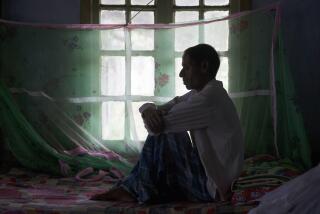The Epidemic
- Share via
The time has long since passed when it was possible for public officials to ignore AIDS or to pretend that it affects only certain people and hope that it will go away. In recent months the National Academy of Sciences and the surgeon general of the United States have joined the Public Health Service in describing AIDS as the country’s No. 1 health problem, and the disease stands a good chance of becoming the most widespread epidemic of modern times.
Yet, because the great majority of people with AIDS and its less-severe precursor, ARC, are homosexuals or drug addicts, many public officials have not felt political pressure or found the political will to put the disease high on their agenda. They don’t think that it’s a mainstream disease, and they don’t want to hear about it. This is a serious mistake that has already cost lives and will continue to until it is undone.
Los Angeles County has seen more than 2,300 of the 28,000 AIDS cases in the United States, but, with the exception of Supervisor Edmund D. Edelman, the supervisors have not shown much interest in the problem and have not appropriated a significant amount of money to deal with it. To be sure, the county has spent several million dollars in providing medical treatment for indigent or uninsured people with AIDS. But that is reactive. The county provides medical care for people who need it but can’t afford it, no matter what their illness. What the county could do and should do is to initiate programs aimed at preventing the spread of AIDS and providing broader care than is now available to AIDS patients.
In the absence of a vaccine or cure, education about how AIDS is transmitted and not transmitted is the only effective way of fighting the epidemic. The county should give its Health Services Department the money to develop and conduct AIDS-education programs for people in the high-risk groups and for the general community, including adolescents, who tend to be sexually active. The public schools should take all steps to implement the sex-education recommendations of the surgeon general’s report.
AIDS is not a disease of male homosexuals only. Heterosexuals are the fastest-growing group of people with it. Unless society can loosen the grip that the AIDS virus has taken on heterosexuals, it will not be long before the pattern that the disease has followed among gays repeats itself among straights. Educational efforts should be directed at all segments of the community, including minority populations and hard-to-reach drug addicts.
The medical cost is enormous, and growing. The cost of AIDS--and of all diseases--is ultimately paid for socially, either through the private insurance system or through the public treasury. This country has yet to come to grips with making this system work both equitably and efficiently. Locally, the county could and should explore alternative means of providing health care to people with AIDS besides hospitalization. Hospices and in-home care are two important options that would probably require changes in state and federal reimbursement rules. It’s time to make those changes.
Ultimately it is up to elected officials to focus public attention and to provide the necessary leadership on vital social issues. The county supervisors could empanel a blue-ribbon commission to hold public hearings and make recommendations for dealing with the AIDS crisis. But it will be up to them to implement those ideas. Too much time has already passed. How many lives might have been saved? The supervisors should act now to save lives in the future.
More to Read
Sign up for Essential California
The most important California stories and recommendations in your inbox every morning.
You may occasionally receive promotional content from the Los Angeles Times.












